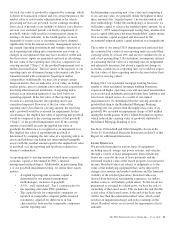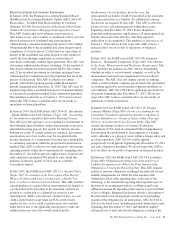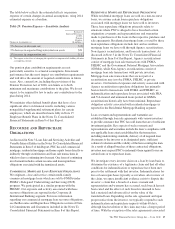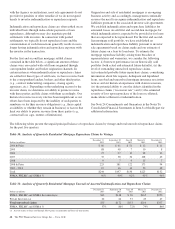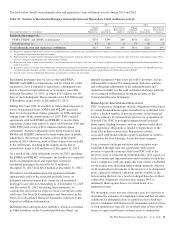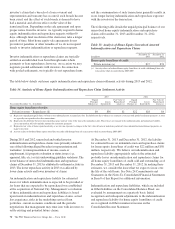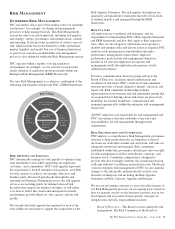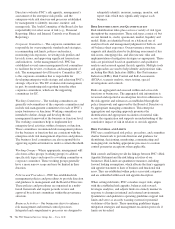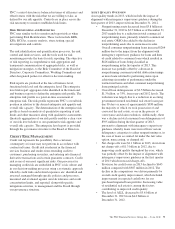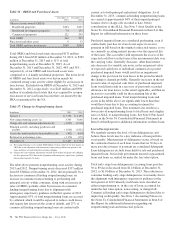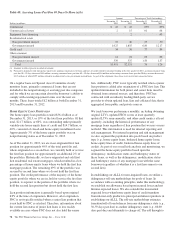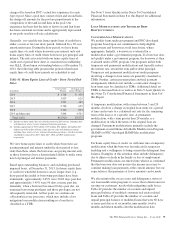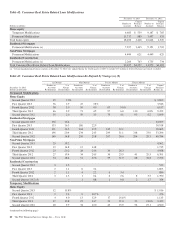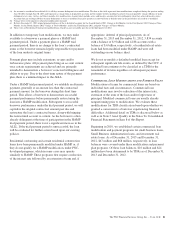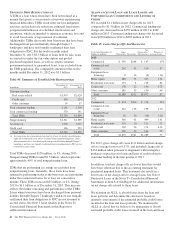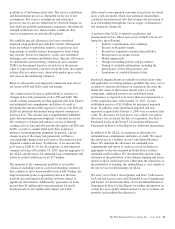PNC Bank 2013 Annual Report Download - page 91
Download and view the complete annual report
Please find page 91 of the 2013 PNC Bank annual report below. You can navigate through the pages in the report by either clicking on the pages listed below, or by using the keyword search tool below to find specific information within the annual report.PNC’s control structure is balanced in terms of efficiency and
effectiveness with the risks that we are willing to take, as
defined by our risk appetite. Controls are in place across the
risk taxonomy to monitor established risk limits.
R
ISK
M
ONITORING AND
R
EPORTING
PNC uses similar tools to monitor and report risk as when
performing Risk Identification. These tools include KRIs,
KPIs, RCSAs, scenario analysis, stress testing, special
investigations and controls.
The risk identification and quantification processes, the risk
control and limits reviews, and the tools used for risk
monitoring provide the basis for risk reporting. The objective
of risk reporting is comprehensive risk aggregation and
transparent communication of aggregated risks, as well as
mitigation strategies, to the Risk Committee of the Board of
Directors, Corporate Committees, Working Committees and
other designated parties for effective decision making.
Risk reports are produced at the line of business level,
functional risk level and the enterprise level. The enterprise
level risk report aggregates risks identified in the functional
and business reports to define the enterprise risk profile. The
enterprise risk profile is a point-in-time assessment of
enterprise risk. The risk profile represents PNC’s overall risk
position in relation to the desired enterprise risk appetite and
overall risk capacity. The determination of the enterprise risk
profile is based on analysis of quantitative reporting of risk
limits and other measures along with qualitative assessments.
Quarterly aggregation of our risk profile enables a clear view
of our risk level relative to our quantitative risk appetite and
overall risk capacity. The enterprise level report is provided
through the governance structure to the Board of Directors.
C
REDIT
R
ISK
M
ANAGEMENT
Credit risk represents the possibility that a customer,
counterparty or issuer may not perform in accordance with
contractual terms. Credit risk is inherent in the financial
services business and results from extending credit to
customers, purchasing securities, and entering into financial
derivative transactions and certain guarantee contracts. Credit
risk is one of our most significant risks. Our processes for
managing credit risk are embedded in PNC’s risk culture and
in our decision-making processes using a systematic approach
whereby credit risks and related exposures are: identified and
assessed, managed through specific policies and processes,
measured and evaluated against our risk tolerance and credit
concentration limits, and reported, along with specific
mitigation activities, to management and the Board through
our governance structure.
A
SSET
Q
UALITY
O
VERVIEW
Asset quality trends in 2013, which include the impact of
alignment with interagency supervisory guidance during the
first quarter of 2013, improved from December 31, 2012.
• Nonperforming assets decreased from $3.8 billion at
December 31, 2012 to $3.5 billion as of December 31,
2013 mainly due to a reduction in total commercial
nonperforming loans, primarily related to commercial
real estate. OREO also added to the decline in
nonperforming assets due to an increase in sales.
Overall consumer nonperforming loans increased $264
million due to the impact from the alignment with
interagency supervisory guidance for loans and lines
of credit related to consumer loans which resulted in
$426 million of loans being classified as
nonperforming in the first quarter of 2013. This
increase was partially offset by a decrease in
nonperforming consumer troubled debt restructurings
as more loans returned to performing status upon
achieving six months of performance under the
restructured terms and other consumer nonperforming
loans principal activity.
• Overall loan delinquencies of $2.5 billion decreased
$1.3 billion, or 33%, from year-end 2012 levels. The
reduction was largely due to a reduction in accruing
government insured residential real estate loans past
due 90 days or more of approximately $830 million,
the majority of which we took possession of and
conveyed the real estate, or are in the process of
conveyance and claim resolution. Additionally, there
was a decline in total consumer loan delinquencies of
$395 million during the first quarter of 2013,
pursuant to alignment with interagency supervisory
guidance whereby loans were moved from various
delinquency categories to either nonperforming or, in
the case of loans accounted for under the fair value
option, nonaccruing, or charged off.
• Net charge-offs were $1.1 billion in 2013, down from
net charge-offs of $1.3 billion in 2012, due to
improving credit quality throughout the year, which
was partially offset by the impact of alignment with
interagency supervisory guidance in the first quarter
of 2013 which increased charge-offs.
• Provision for credit losses in 2013 declined to $643
million compared with $987 million in 2012. The
decline in the comparisons was driven primarily by
overall credit quality improvement, which included
improvement in expected cash flows for our
purchased impaired loan portfolio. Increasing value
of residential real estate is among the factors
contributing to improved credit quality.
• The level of ALLL decreased to $3.6 billion at
December 31, 2013 from $4.0 billion at
December 31, 2012.
The PNC Financial Services Group, Inc. – Form 10-K 73


